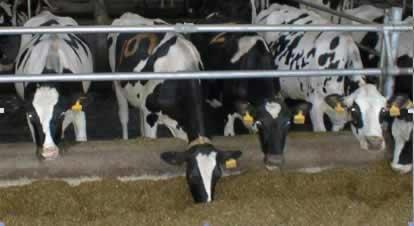Attention to cow comfort by producers and researchers alike has usually focused on improving conditions for lying down in the stall (see previous UBC Research Reports dealing with this subject). This focus is appropriate, as cows spend about half the day lying down in the stall, and problems with stall design are known to contribute to health problems such as lameness.
Another important activity for cows is feeding. Housed lactating cows spend about 5 hours a day at the feed bunk. Access to feed is important in maintaining health and high levels of milk production. Despite the importance of this activity, very little research has been done on how to design a comfortable environment for feeding.

Figure 1. Cows spend about one-quarter of their day at the feed bunk. Creating comfortable environments for feeding is one important focus of current UBC Dairy Centre research.
This report describes two recent UBC studies designed to improve the feeding environment. In the first study, we examined the surface that cows stand upon when eating. In the second study, we tested how the density of cows at the feed bunk affects feeding behaviour and social competition.
Concrete is a popular flooring surface in dairy barns due to its durability, availability, cost and ease of cleaning. Unfortunately, use of concrete flooring is known to contribute to the risk of cows developing hoof injuries and lameness. Concrete floors may also affect the comfort of cows, reducing important behaviours such as time spent eating and displays of estrus. Alternative flooring surfaces such as rubber are becoming popular with some producers, but no previous research has tested if these surfaces provide real improvements in comfort for cows.
The objective of this experiment was to test if rubber flooring in the area where the cow stands at the feed bunk increased feeding time and time spent standing at the feed bunk. Four groups of 12 cows each were tested with both 1” solid rubber flooring and grooved concrete in this area. Each group was observed for a 3-week period on each surface, and individual cow behavioural responses were recorded with time-lapse video equipment.
We found that providing rubber flooring for the cows to stand on did not affect the amount of time they spent eating. However, cows showed a slight increase in time standing without eating when they were provided the rubber surface.
In conclusion, access to rubber flooring at the feeder has little affect on cow behaviour. However, softer surfaces may provide longer-term benefits in terms of hoof health and lameness. Current research at the Dairy Centre is focusing on these issues.
Regardless of how well we design and build barns for cows, the ability of animals to benefit from the design is limited by the space made available to them. When grazing, cattle often synchronize their behavior such that many animals in the group feed, ruminate, and rest at the same times. This synchronization is normally reduced when cattle are housed indoors, likely because of competition for space or food. If feeding space is limited, increased competition among cows at the feeder may prevent access to feed during peak-feeding times, especially for subordinate cows.
The objective of the second study was to determine if increasing space availability at the feed bunk improves access to feed and reduces social competition. Twenty-four lactating Holstein cows were each tested under two conditions: with 0.5 m or 1.0 m of feeding space per cow. Time-lapse video and an electronic feed alley monitoring system were used to monitor cow behaviour. When animals had access to more space we observed 57% fewer aggressive interactions while feeding. This reduced aggressive behaviour allowed cows to increase feeding activity throughout the day (see Figure 2). The increase in feeding activity was especially noticeable during the 90 minutes after fresh feed was provided. During this period, cows with access to more feeding space, increased time at the feeder by 24%, and this effect was strongest for subordinate cows.
In conclusion, providing more space at the feed bunk increases feeding time and reduces competition among lactating dairy cows.

Figure 2. Percentage of cows present at the feed bunk over the course of the day for both 0.5 m and 1.0 m feeding space per cow treatments.
This article is based on research of by visiting Professor Jose Fregonesi and Ph.D. student Trevor DeVries. Dan Weary and Nina von Keyserlingk are faculty members in UBC’s Animal Welfare Program.
Nina and Dan thank the Dairy Farmers of Canada, BC Dairy Foundation, BC Milk Producers, Westgen and many others in the dairy industry for their support of this research. Supporters are listed at the Animal Welfare Program.
